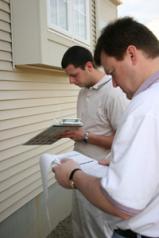

HomePro provides everything from Inspections to Water Testing. What we can do for you:
- Home Inspections (using Infrared Technology, which is like an MRI for your HOME!)
- 5 Star Inspection™ Package: ASHI Certified Home Inspection, Wood Destroying Organisms Report (provided by A7), Infrared Survey, Mold Screening, and Moisture Analysis. PLUS FREE WDO Warranty, and your choice of a Wind Mitigation Report (1802) or a 4 Point Insurace Letter. All reports delivered on site at the end of the inspection appointment!
-
4 Star Inspection™ Package: ASHI Certified Home Inspection, Infrared Survey, Mold Screening, and Moisture Analysis, PLUS FREE Wind Mitigation Inspection (1802) or a FREE 4 Point Insurance Letter. All reports delivered on site at the end of the inspection appointment!
- Condominium Inspections
- Multi-family units; Duplexes, Triplexes, etc.
- Home Re-Inspections
- New Home Construction Monitoring Inspections (5 phases; pre-slab, pre-drywall, frame, trim out, final – or any combination)
- Home Warranty Inspections (1 Year Warranty, or 11-month inspections)
- Insurance Letters – 4 Point (Roof, Electrical, HVAC, and Plumbing)
- Wind Mitigation Inspections – aka the 1802
- Structural Letters
- Moisture Intrusion Inspections
- Commercial Building Inspections
- FHA Compliance Inspections
- Mobile Home Inspections
- WDO (Termite) inspection provided by A7
- Water Sampling: For any one of 3 tests; bacterial, lead, or chemicals (as part of a complete home inspection only)
- Lead Paint Testing (as part of a complete home inspection only)
- Air Sample Testing
What are we going to inspect?
Inspectors using the HOMEBOOK cover more than 500 potential problem areas, which are then recorded under one of eight sections in the book:
Structural
Covers the structure of the building in terms of materials used and type of construction. Foundation type, framing materials, and other significant sub-components are noted along with any idiosyncrasies. The inspector/surveyor also checks for major or minor problems in the foundation, floor, wall and roof framing.
Sample from the HOMEBOOK – Structure.pdf
Electrical
The electrical system is checked for sufficient capacity and safety, and evaluated in terms of its current condition and suitability for future use. Upgrades and repairs are recommended where appropriate.
Sample from the HOMEBOOK – Electrical.pdf
Heating and Air Conditioning
The inspector assesses the capacity of the existing equipment, and by considering the age of the equipment and its intended capacity, approximates the life expectancy and recommends appropriate repairs an upgrades.
Sample from the HOMEBOOK – Heat-AC.pdf
Plumbing
The piping and fixtures throughout the house are checked for function flow and life expectancies. They are screened for unsanitary conditions and potential repairs, freeze vulnerability, or spillage/overflow. Laundry equipment, tile work, and domestic water heating equipment are also surveyed.
Sample from the HOMEBOOK – Plumbing.pdf
Basement / Crawl Space / Slab
Water seepage probabilities and structural problems are evaluated and remediation advice given if needed. The inspector also looks for possible problem areas that could cause structural problems, such as poor soil, surface drainage, proximity to tree roots and rotating stoops.
Sample from the HOMEBOOK – vSlab.pdf
Kitchen
All appliances are operated and deficiencies noted. The inspector approximates the age of each piece and its life expectancy. The inspector may also, depending on the age and usefulness of the kitchen, suggest a budget for repairs ranging from addressing typical minor problems to a complete renovation.
Sample from the HOMEBOOK – Kitchen.pdf
Interior
Walls, floors and ceiling surfaces are scanned for problematic conditions, visible evidence of water penetration, potentially dangerous or toxic materials, fire hazards, or security breaches. Ventilation and energy conservation aspects are checked and appropriate upgrades are itemized.
Sample from the HOMEBOOK – Interior.pdf
Exterior
The roof (where safe and appropriate), roof runoff controls and landscape drainage are inspected and necessary improvements are recommended. Stoops, steps, walks and drives are checked for voids, surface problems and safety hazards.
Sample from the HOMEBOOK – Exterior.pdf
 home
home
 contact
contact
 About Us
About Us
 Services
Services
 Windermere Homemove
Windermere Homemove


